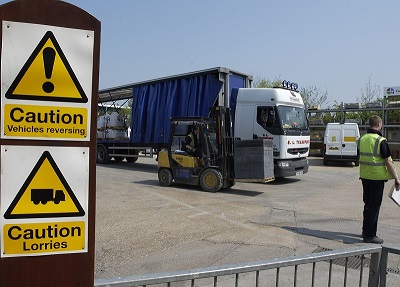Workplace transport – let’s get back to basics
By Paul Barker, Health and Safety Consultant at Southalls
7 January 2020

Pedestrian collisions. Forklift truck accidents. Objects falling during loading and unloading. Transport incidents cause a significant number of workplace injuries and deaths every year, shattering lives and livelihoods across every sector. The common thread? Most are entirely preventable with a common sense approach to compliance.
While there’s no one-size-fits-all safety solution, a few fundamental fixes could considerably reduce risk across your business.
Map out traffic flow
Every site has a unique layout and it’s every employer’s responsibility to identify their own transport patterns, space constraints and safety requirements. Begin with a simple observation exercise, assessing the movement of vehicles, forklift trucks, cars and pedestrians throughout your workplace. Then carry out a more formal risk assessment covering traffic routes and their inherent hazards, such as junctions, gradients and potential collision points.
Separate vehicles and pedestrians
As far as is practicable, keep moving vehicles and forklift trucks away from workers and site visitors. Isolate pedestrian walkways with physical boundaries, such as protective barriers or rails, and safeguard vehicle routes with appropriate signage, speed limits and designated loading/unloading areas.
Banish stock blind spots
As well as presenting a crushing hazard, overloaded racking systems can create perilous blind spots. Stock should never impede views or traffic flow, consider installing ceiling or wall mounted safety mirrors to improve visibility.
Go above and beyond
Even with solid transport safety measures in place, it’s vital to recognise when temporary supporting measures such as barriers and cones are needed. Staging a public event - like a breakfast? Planning construction work? A supplementary risk assessment will help pinpoint additional requirements during this time
Stack safely
According to the British Safety Council, around 1,300 UK employees are seriously injured each year as a result of forklift accidents. Stacking is a recurrent risk area, so ensure workers are properly trained on correct methods of pallet placement and removal.
Block offloading areas
Where possible, establish segregated loading and unloading areas that allow drivers to easily manoeuvre. Nearly a quarter of all transport-related workplace deaths happen while vehicles are reversing, so eliminate the need by implementing one-way systems. Light the way In a bustling work environment, staff can tune out traditional sound-based warning systems like back-up beepers. Blue spot technology – which projects a bright blue LED light in the path of a moving forklift – alerts pedestrians and other vehicles to approaching traffic.
Create safe zones for drivers
Structure your site to ensure hazard-free delivery and collection of goods. Purpose-built safe areas keep drivers and other workers protected during loading and unloading. Similarly, clear signage, speed limits and one-way systems keep traffic flowing in predictable patterns.
Insist on safety
Some safety measures are simply non-negotiable. Seatbelts should be standard, along with correct training for varying vehicle types. Workers should never drive under the influence of alcohol, drugs or prescription medication that may cause drowsiness, and mobile phones are always safest stowed whilst driving or present in the yard.
BUILDERS MERCHANTS SAFETY THAT KEEPS YOU A STEP AHEAD.This article was written by Southalls, BMF Safety Plus Services provider. Southalls consultants push your approach beyond simple box-ticking, helping you transform standards and create a compliance-based culture. We start with a bespoke, business-wide safety audit based on your specific needs, as well as common issues of safety in builders merchants, then provide the hands-on expertise to ensure you meet legal requirements, and much more. Get in touch to request your complimentary visit and preview the power of best health and safety practice.